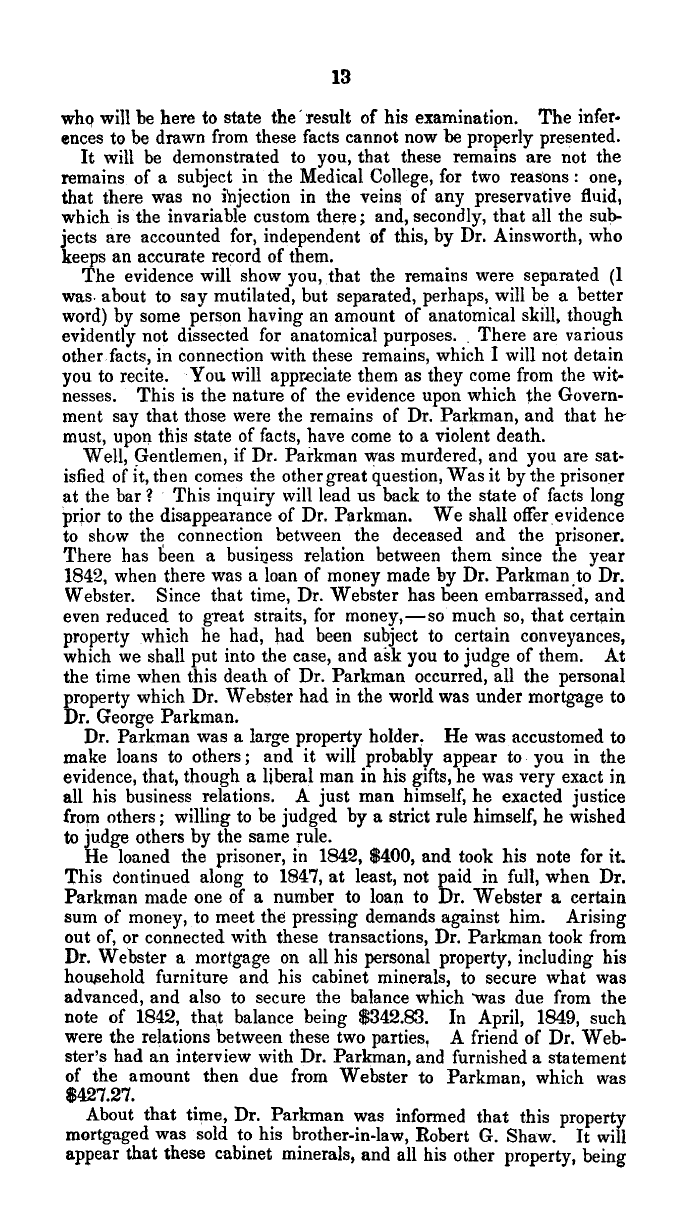|
13
who will be here to state the'result of his examination. The infer-
ences to be drawn from these facts cannot now be properly presented.
It will be demonstrated to you, that these remains are not the
remains of a subject in the Medical College, for two reasons: one,
that there was no injection in the veins of any preservative fluid,
which is the invariable custom there; and, secondly, that all the sub-
.
]ects are accounted for, independent of this, by Dr. Ainsworth, who
keeps an accurate record of them.
The evidence will show you, that the remains were separated (1
was. about to say mutilated, but separated, perhaps, will be a better
word) by some person having an amount of anatomical skill, though
evidently not dissected for anatomical purposes. There are various
other facts, in connection with these remains, which I will not detain
you to recite. You will appreciate them as they come from the wit-
nesses. This is the nature of the evidence upon which the Govern-
ment say that those were the remains of Dr. Parkman, and that he-
must, upon this state of facts, have come to a violent death.
Well, Gentlemen, if Dr. Parkman was murdered, and you are sat-
isfied of it, then comes the other great question, Was it by the prisoner
at the bar ? This inquiry will lead us back to the state of facts long
prior to the disappearance of Dr. Parkman. We shall offer,evidence
to show the connection between the deceased and the prisoner.
There has been a business relation between them since the year
1842, when there was a loan of money made by Dr. Parkman to Dr.
Webster. Since that time, Dr. Webster has been embarrassed, and
even reduced to great straits, for money,-so much so, that certain
property which he had, had been subject to certain conveyances,
which we shall put into the case, and ask you to judge of them. At
the time when this death of Dr. Parkman occurred, all the personal
property which Dr. Webster had in the world was under mortgage to
Dr. George Parkman.
Dr. Parkman was a large property holder. He was accustomed to
make loans to others; and it will probably appear to you in the
evidence, that, though a liberal man in his gifts, he was very exact in
all his business relations. A just man himself, he exacted justice
from others; willing to be judged by a strict rule himself, he wished
to judge others by the same rule.
He loaned the prisoner, in 1842, $400, and took his note for it.
This dontinued along to 1847, at least, not paid in full, when Dr.
Parkman made one of a number to loan to Dr. Webster a certain
sum of money, to meet the pressing demands against him. Arising
out of, or connected with these transactions, Dr. Parkman took from
Dr. Webster a mortgage on all his personal property, including his
hou.sehold furniture and his cabinet minerals, to secure what was
advanced, and also to secure the balance which was due from the
note of 1842, that balance being $342.83. In April, 1849, such
were the relations between these two parties, A friend of Dr. Web-
ster's had an interview with Dr. Parkman, and furnished a statement
of the amount then due from Webster to Parkman, which was
$427.27.
About that time, Dr. Parkman was informed that this property
mortgaged was sold to his brother-in-law, Robert G. Shaw. It will
appear that these cabinet minerals, and all his other property, being
|

